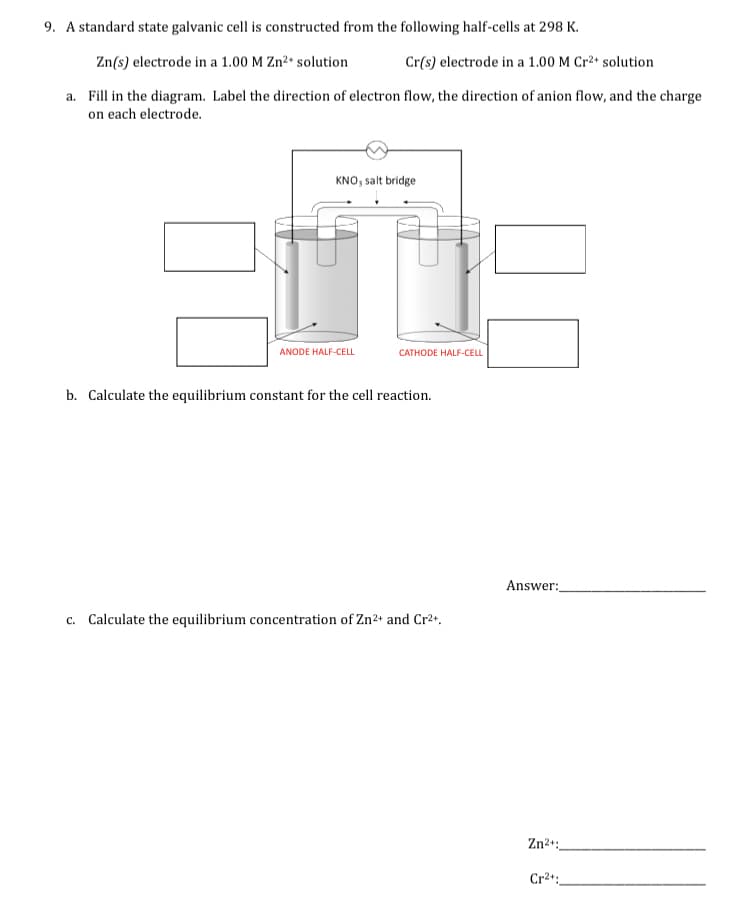9. A standard state galvanic cell is constructed from the following half-cells at 298 K. Zn(s) electrode in a 1.00 M Zn²ª solution Cr(s) electrode in a 1.00 M Cr²+ solution a. Fill in the diagram. Label the direction of electron flow, the direction of anion flow, and the charge on each electrode. KNO, salt bridge ANODE HALF-CELL CATHODE HALF-CELL b. Calculate the equilibrium constant for the cell reaction. Answer: c. Calculate the equilibrium concentration of Zn2+ and Cr2. Zn2+: Cr2*:
9. A standard state galvanic cell is constructed from the following half-cells at 298 K. Zn(s) electrode in a 1.00 M Zn²ª solution Cr(s) electrode in a 1.00 M Cr²+ solution a. Fill in the diagram. Label the direction of electron flow, the direction of anion flow, and the charge on each electrode. KNO, salt bridge ANODE HALF-CELL CATHODE HALF-CELL b. Calculate the equilibrium constant for the cell reaction. Answer: c. Calculate the equilibrium concentration of Zn2+ and Cr2. Zn2+: Cr2*:
Chemistry
10th Edition
ISBN:9781305957404
Author:Steven S. Zumdahl, Susan A. Zumdahl, Donald J. DeCoste
Publisher:Steven S. Zumdahl, Susan A. Zumdahl, Donald J. DeCoste
Chapter18: Electrochemistry
Section: Chapter Questions
Problem 159MP: A galvanic cell is based on the following half-reactions: In this cell, the copper compartment...
Related questions
Question

Transcribed Image Text:9. A standard state galvanic cell is constructed from the following half-cells at 298 K.
Zn(s) electrode in a 1.00 M Zn²• solution
Cr(s) electrode in a 1.00 M Cr2+ solution
a. Fill in the diagram. Label the direction of electron flow, the direction of anion flow, and the charge
on each electrode.
KNO, salt bridge
ANODE HALF-CELL
CATHODE HALF-CELL
b. Calculate the equilibrium constant for the cell reaction.
Answer:
c. Calculate the equilibrium concentration of Zn2+ and Cr2+.
Zn2+:
Expert Solution
This question has been solved!
Explore an expertly crafted, step-by-step solution for a thorough understanding of key concepts.
This is a popular solution!
Trending now
This is a popular solution!
Step by step
Solved in 2 steps with 2 images

Knowledge Booster
Learn more about
Need a deep-dive on the concept behind this application? Look no further. Learn more about this topic, chemistry and related others by exploring similar questions and additional content below.Recommended textbooks for you

Chemistry
Chemistry
ISBN:
9781305957404
Author:
Steven S. Zumdahl, Susan A. Zumdahl, Donald J. DeCoste
Publisher:
Cengage Learning

Chemistry: An Atoms First Approach
Chemistry
ISBN:
9781305079243
Author:
Steven S. Zumdahl, Susan A. Zumdahl
Publisher:
Cengage Learning


Chemistry
Chemistry
ISBN:
9781305957404
Author:
Steven S. Zumdahl, Susan A. Zumdahl, Donald J. DeCoste
Publisher:
Cengage Learning

Chemistry: An Atoms First Approach
Chemistry
ISBN:
9781305079243
Author:
Steven S. Zumdahl, Susan A. Zumdahl
Publisher:
Cengage Learning


Principles of Modern Chemistry
Chemistry
ISBN:
9781305079113
Author:
David W. Oxtoby, H. Pat Gillis, Laurie J. Butler
Publisher:
Cengage Learning

Chemistry by OpenStax (2015-05-04)
Chemistry
ISBN:
9781938168390
Author:
Klaus Theopold, Richard H Langley, Paul Flowers, William R. Robinson, Mark Blaser
Publisher:
OpenStax
